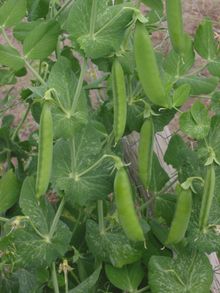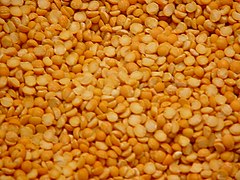Cookbook:Pea
| Pea | |
|---|---|
 | |
| Category | Pulses |
Cookbook | Recipes | Ingredients | Equipment | Techniques | Cookbook Disambiguation Pages | Ingredients | Vegetables | Legume


The pea (Pisum sativum) is a legume cooked as a vegetable in many cultures. It should not be confused with the pigeon pea, cowpea, or other legumes sometimes referred to as peas. There are many varieties and cultivars, and both the greens and fruits (pods and seeds) are eaten. Often the term "pea" refers specifically to the seeds extracted from the pods, although some varieties have edible pods.
Characteristics
[edit | edit source]Pea pods and their seeds are typically green, and sometimes yellow or purple. The shoots are green.
Harvest and processing
[edit | edit source]Fresh immature peas, sometimes called garden peas, are harvested in their pods when tender. The pods may be sold whole and the seeds extracted at home, or they may be commercially seeded and sold frozen or canned. Mature peas, sometimes called marrowfat or field peas, are left to dry in the field. They are then shelled before cooking. Split peas are made by peeling of the outer skin of harvested dried peas before splitting them in half. Sugar peas or mangetout, which include snap peas and snow peas, have edible pods and smaller seeds—these are typically eaten whole.
Pea sprouts are the first few inches of freshly-sprouted peas. Pea greens, also called pea shoots or tendrils, are tender young stems, tendrils, and leaves of the plants. Both sprouts and shoots are used as fresh vegetables.
Uses
[edit | edit source]Dried peas are often made into a soup or stew or simply eaten on their own. Fresh peas are often eaten boiled and flavored with butter as a side dish vegetable. Fresh peas are also used in pot pies, stews, salads, and casseroles. Sugar peas are used in stir fried dishes.
In the UK, dried, rehydrated and mashed marrowfat peas, known by the public as "mushy peas", are popular, originally in the north of England but now ubiquitously, and especially as an accompaniment to fish and chips or meat pies, particularly in "chippies" or fish and chip shops. They may also be used to make the traditional dish pease pudding. These same peas are also sold in cans, but not mashed. These are sold as "Processed Peas", named after the process of drying, rehydrating, then adding artificial colour and sometimes artificial mint flavouring. Sodium bicarbonate is sometimes added to soften the peas.
In Japan and other Far Eastern countries, such as Thailand, Taiwan and Malaysia, peas are roasted, salted, and eaten as snacks.
Gallery
[edit | edit source]-
Cooked fresh peas
-
Peas in a pod
-
Split dried yellow peas
-
Peas being shelled (removed from the pod)



